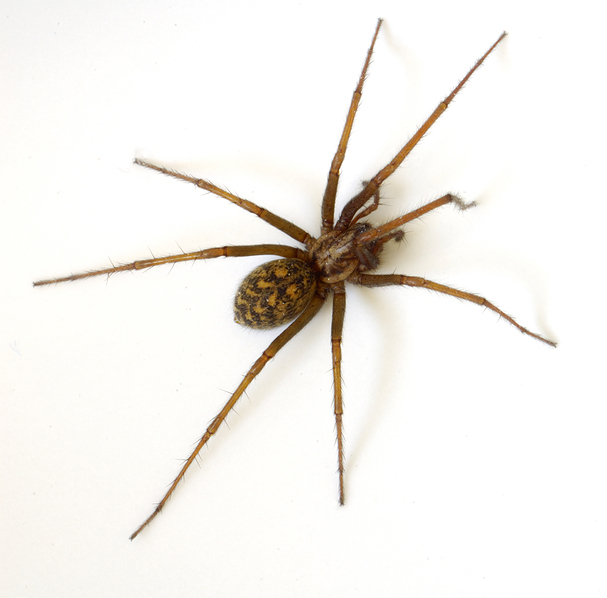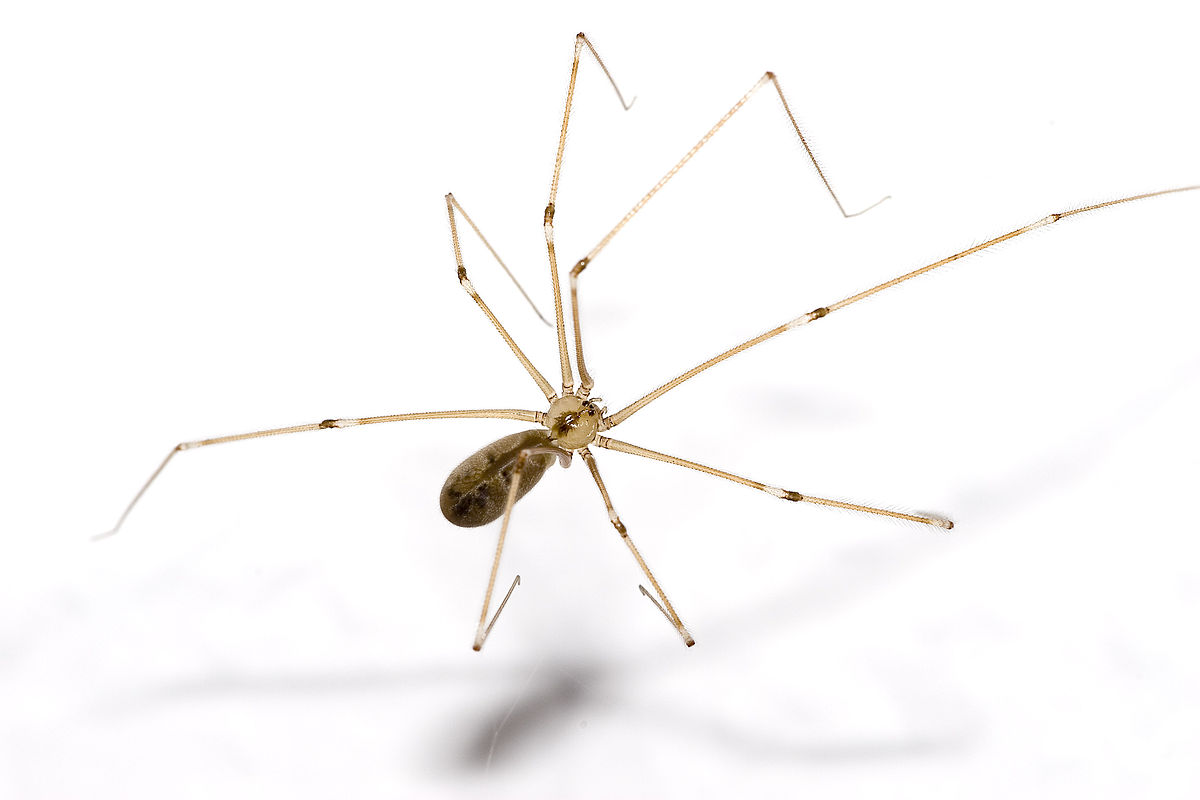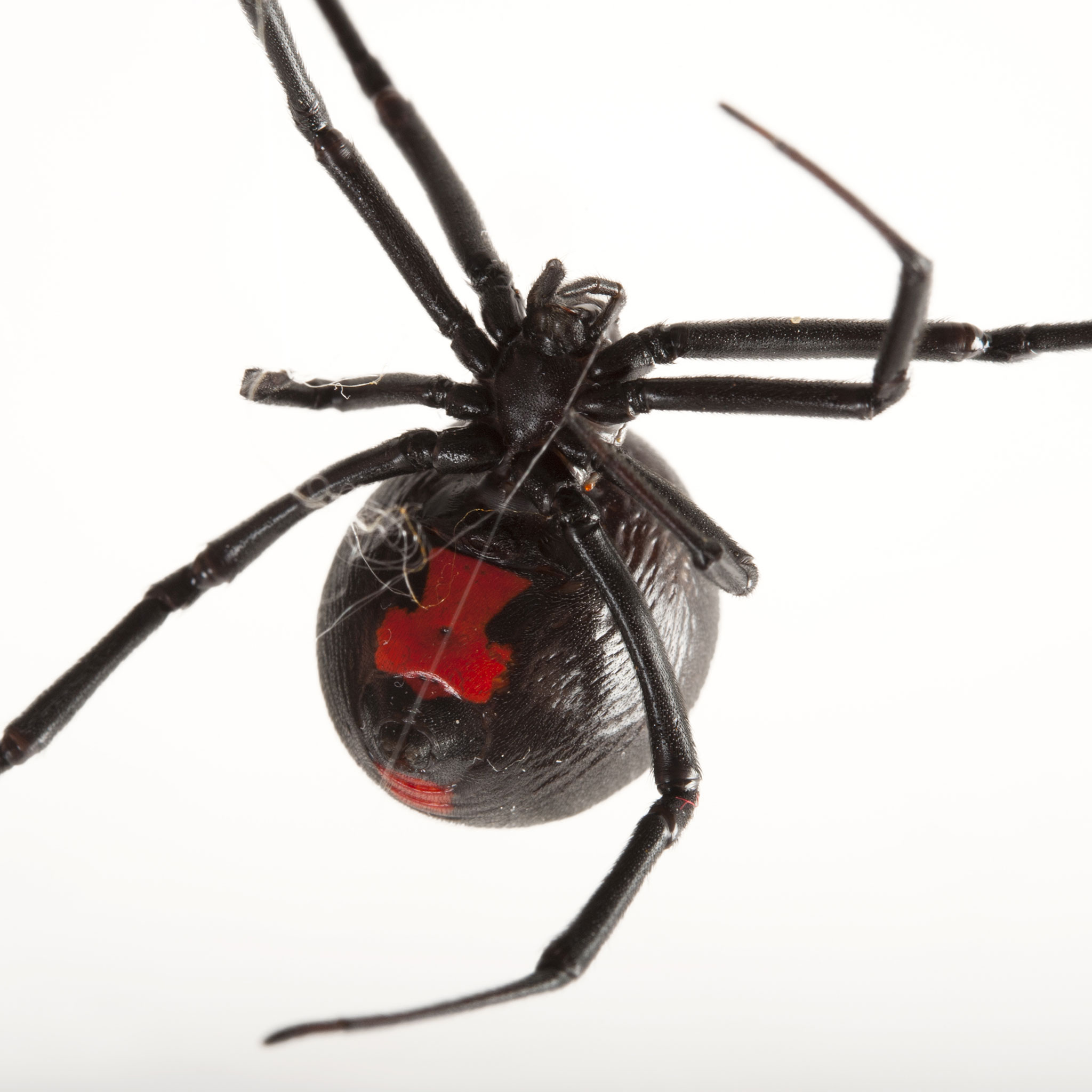
J & L Pest Control is a family owed business that has been practicing Integrated Pest Management (IPM) services since it was founded.
T (631)-605-9919
Email: jandlpestcontrol@gmail.com
J & L Pest Control
1090 Martinstien Ave.
Bay Shore, NY 11706

INTRODUCTION. The common names reflect the fact that this is usually the spider most often encountered indoors. It is a nuisance pest, probably more because of its webs than the spider itself. This spider is found worldwide and is common throughout the United States and Canada.
RECOGNITION. Adult female body length about 3/16-5/16" (5-8 mm) including an almost spherical abdomen, male body length about 1/8-3/16" (3.8-4.7 mm) including an elongated abdomen. Color highly variable with carapace (cephalothorax dorsum) yellowish brown; abdomen dirty white with a few dark spots (sometimes with a black triangular spot in center of dorsum) to almost black, with several dark stripes meeting at angle medially (=chevrons/“army sergeant stripes") above tip of abdomen; legs orange in male but yellow in female, with dusky ring at end of each segment (=banded). With 8 eyes, 2 lateral pairs almost touching. Last tarsal segment of 4th pair of legs with row/comb of serrated bristles on venter; all tarsi with 3 claws each.
SIMILAR GROUPS. (1) Other Achaearanea spp. lack chevrons on abdomen. (2) Tidarren sisyphiodes with a distinctive white stripe on posterior of abdomen. (3) Other spiders lack comb of serrated bristles on last tarsal segment of 4th pair of legs and 8 eyes with 2 lateral pairs almost touching.
BIOLOGY. Female house spiders lay about 250 eggs (range 132-442) in a silken sac which is brownish, oval to flask-shaped, about 1/4-3/8" (6-9 mm) in diameter, and with a tough, papery cover. There may be more than one sac in the web at a time; a female may produce up to 17 sacs, containing over 3,760 eggs, in her lifetime. The sacs are usually located in the center of the web but may be moved to warmer or cooler sites as required. The eggs hatch in about 7-10 days but the 1st instar spiderlings remain in the sac until they molt once. The 2nd instar spiderlings then emerge and balloon. Females molt 7 times and males 6 or 7 times to reach maturity. Adults may live for a year or more.
HABITS. The house spider randomly selects its web sites and creates a tangled web. If a web does not yield prey (food) it is abandoned, another site is selected, and a new web uilt. Eventually, successful webs are constructed where air currents bring in prey. Survival is low in modern homes with low humidity and few insects, higher in garages, sheds, barns, warehouses, etc. because of more prey and generally higher humidity, and highest outdoors in protected places.
Inside structures, house spiders are most likely to be found in upper corners, under furniture, in closets, angles of window frames, basements, garages, and crawl spaces. In warehouses, they are common in corners near doors that stay open. Outside, they are often around windows and under eaves especially near light sources which attract prey.
Because of their web site selection by trial and error, many webs may be constructed in several days. Dust collecting on these webs accentuates their presence. This situation is unacceptable in most households, offices, food processing plants, etc.
CONTROL. Follow the standard control procedures for spiders as outlined in the introductory section.
Use a vacuum to remove adults, egg sacs, and webs. If a broom is used, adults usually escape unless they are first individually treated with a nonresidual contact pesticide; this can leave marks or dirt/dust on wall and ceiling surfaces.

INTRODUCTION. The common name cellar comes from these spiders being frequently found in dark and damp places such as cellars, basements, and crawl spaces, and that of daddylonglegs from their very long, thin legs which give them an appearance somewhat similar to harvestmen/daddylonglegs (order Opiliones, family Phalangiidae; see similar groups below). Cellar spiders are nuisance pests, probably more because of their webs than the spider itself. About 20 species are found in the United States and Canada.
RECOGNITION. Adult body length ranges from about 1/16-5/16" (2-8 mm); cephalothorax and abdomen connected by tiny waist (pedicel) but appearing as small body with very long, thin legs. Color usually pale yellowish to light brown or gray. Usually with 8 eyes, some species with 6, usually with 2 widely spaced groups of 3 closely-spaced eyes each and 2 eyes in between. Chelicerae (fangs) fused at base, cheliceral claw short and opposed (closes to/opposite) by a short toothlike projection of basal segment. Abdomen either globose or elongate. Tarsi with 3 claws each.
SIMILAR GROUPS. (1) Harvestmen/Daddylonglegs (order Opiliones, family Phalangiidae) with cephalothorax and abdomen broadly connected giving appearance of singular oval body, 1 pair ocelli, and tarsi with 1 claw each.
REPRESENTATIVE SPECIES.
1. Long-bodied cellar spider, Pholcus phalangioides (Fuesslin). Adult female body . length about 1/4-5/16" (7-8 mm) with front legs about 1 3/4-1 15/16" (45-50 mm) long, male body length about 1/4" (6 mm); with 8 eyes in 2 lateral groups of 3 each and 2 smaller eyes in between; abdomen elongate, cylindrical, about 3 times longer than wide; found worldwide.
2. Short-bodied cellar spider, Spermophora meridionalis Hentz. Adult female body length about 1/16" (2 mm) with front legs about 5/16" (8.5 mm) long, male body length about 1/16" (1.6 mm) with front legs about 3/8" (9.5 mm) long; cephalothorax pale yellow with 2 light gray spots, abdomen pale yellow; with 6 eyes in 2 lateral groups of 3 each; abdomen globose; found in eastern United States.
BIOLOGY. The long-bodied female cellar spider may produce up to 3 egg sacs containing 13-60 eggs each. The sacs are very thin such that the cluster of eggs shows through, giving the appearance of an unripened blackberry. The female typically carries the egg sac between her chelicerae (jaws) until they hatch. The emerging spiderlings often cling to their mother for a short time. There are 5 molts before maturity is reached, and this usually requires about 1 year. Adults typically live about 2 years.
The short-bodied female cellar spider produces a similar egg sac containing 10-27 eggs each, and also carries it in her chelicerae.
HABITS. Cellar spiders construct loose, irregular webs in corners. They hang upside down on the underside of the web. The webs are not cleaned but instead new web is y continually added. This habit can result in extensive webbing in a relatively short time.
Webs are commonly found in dark and damp places such as cellars, basements, and crawl spaces. They can also be found in the corners of garages, sheds, barns, and warehouses, on eaves, windows, and ceilings, and in closets, sink cabinets, and bathtraps. In commercial buildings and warehouses, these spiders tend to be in corners near doors which are left open. Open doors allow many flying insects to enter which means more food.
Cellar spiders seem to fare better in areas with higher relative humidity (RH). The higher RH may be due to older construction, improperly vented crawl spaces, excessive ground moisture, improperly sealed basement walls, leaking/sweating plumbing pipes, leaky flashing, roof problems, etc. This increased RH attracts and helps support insect prey.
When disturbed on its web, the long-legged cellar spider has the habit of rapidly shaking its body in a rotary movement. This causes the web to vibrate enough to blur both spider and web, making the spider seem to disappear. If the disturbance is caused by insect prey, this vibration helps to further entangle the prey. If disturbed too much, the spider will retreat to a corner or drop from the web to escape.
CONTROL. Follow the standard control procedures for spiders outlined in the introductory section. Lowering the RH can be helpful in discouraging these spiders and their insect prey.

INTRODUCTION. These spiders get their common name from the popular belief that the female eats the male after mating, a phenomenon which rarely happens in nature. The genus Latrodectus is worldwide in distribution, with 5 species occurring in the United States. Recognition of the genus is sufficient for PMP purposes.
RECOGNITION. Adult female body length about 1/2" (12-13 mm) including an almost spherical abdomen about 1/4-3/8" (7.2-9.6 mm) in diameter, with overall length including legs of about 1 1/2-1 3/8" (38-43 mm); males about half female size. Color typically black, abdomen on ventral or underneath side with 2 reddish triangular markings usually joined to form a reddish hourglass-shaped marking but sometimes separated (“split-hourglass”) or only a single mark; usually with red markings above spinnerets in eastern species. Females usually black (occasionally brownish black; red widow of Florida with cephalothorax and legs usually bright orange, sometimes yellow or brick red); males usually with color pattern on dorsal or upper surface, pattern variable but typically consists of a median row of red spots with white lines or bars radiating out to sides. With 8 simple eyes, 2 lateral pairs almost touching. Last tarsal segment of 4th pair of legs with row/comb of serrated bristles on venter; all tarsi with 3 claws each.
Young spiders primarily orange and white but acquire more and more black as they mature, with markings very similar to those of males. With' 1 or 2 reddish markings on underneath side of abdomen.
REPRESENTATIVE SPECIES. Identification to species is left to experts since several species are involved and species separation is based primarily on differences in the male genitalia. Although a very brief description based on female coloration is given below, it must be realized that color and markings are not always reliable characteristics for separation of these species and that males are usually colored and marked quite differently.
1. Latrodectus bishopi Kaston, the red widow. Cephalothorax reddish, abdomen black with reddish to orangish spots outlined by white, red marks on venter, and legs reddish; occurs only in central and southern Florida.
2. Latrodectus geometricus (Fabricius), the brown widow. Color brown or grayish- brown, abdomen with 3 white spots on top, with a median white band on rear, with 4 diag- W onal white bands on either side, and with a yellow to orange hourglass mark on underside,
legs dark banded/ringed; occurs only along the Gulf Coast of Louisiana and Mississippi, in southern Georgia, in Florida from Jacksonville southward, and recently established in southern California from San Diego to Los Angles.
3. Latrodectus hesperus Chamberlin and Ivie, the “western” widow. Color blackish, abdomen with ventral red hourglass mark complete, anterior triangular part longer and broader than posterior triangle, red spot above anal tubercle (just above spinnerets) usually absent; occurs in the western United States and western Canada.
4. Latrodectus mactans (Fabricius), the southern black widow. Color blackish, abdomen with ventral red hourglass mark complete, posterior half more a rounded rectangle than a triangle, often with a red spot just above anal tubercle (just above spinnerets), and/or with row of red spots dorsally along midiine; occurs primarily from Massachusetts to Florida and west to Texas, Oklahoma, and Kansas, but is most common in the southern states.
5. Latrodectus variolus Walckenaer, the northern black widow. Color blackish, abdomen usually with separated red hourglass mark, having posterior mark triangular and anterior mark rounded, dorsally with row of red spots along midline and diagonal white bands laterally; occurs in the same area as the black widow but is also found in the northern states and in Canada and is more common in the northern states.
SIMILAR GROUPS. (1) All other spiders lack a hourglass-shaped or split-hourglass y / marking on underside of abdomen and/or comb of serrated bristles on last tarsal segment of 4th pair of legs and 8 eyes with 2 lateral pairs almost touching.
BIOLOGY. Female black widow spiders deposit their eggs in silken egg sacs which are about 3/8-1/2" (9.5-12 mm) in diameter, can be constructed in 1-3 hours, and are white but soon turn pale brown. Depending on the species, the maximum number of sacs per female ranges from 6 to 21 and the average number of eggs per sac is about 185-464 maximum 917). The sac’s outer covering is tough and closely woven. The incubation peri¬od ranges from 8 to 30 days.
When newly hatched, the spiderlings undergo the first molt within the sac. They go through 4 to 9 instars in 54 to 107 days respectively, with each instar having different coloration and/or color pattern.
Most of the spiders overwinter as immature individuals, develop into adults in the spring, and die in late July, taking nearly a year to grow from egg to adult. The maximum number of days survived after maturity ranges from 822 to 952 for females and 127 to 196 for males, depending on the species.
These spiders spin an irregular web and hang from it in an inverted or upsidedown position. The web is used to ensnare prey. The female avoids light in sheltered places, and tends to work her web at night.
In terms of toxic bites, only the female is of concern. The male’s poison/venom sacs cease development and he does not attack prey upon maturity. Spiderlings are poisonous when ingested until they are 18 days old, and then lose their toxicity; adults have a different kind of venom.
The black widow's venom is a neurotoxin. The female is normally shy and retiring, but aggressively attacks immediately after egg laying and when guarding her eggs. The black widow bite is not always felt, so the only reliable evidence of a bite is a slight local swelling with 2 tiny red spots where the fangs entered. However, pain is usually almost immediate and reaches its maximum in 1-3 hours, continues for 12-48 hours, and then gradually subsides. The major symptoms are increased body temperature and blood pressure, profuse sweating, and nausea. There is an antivenom available. Immediately call a physi¬cian or go to an emergency room if bitten and take the spider along for identification pur¬poses. If treated, bites are rarely fatal except occasionally in small children.
HABITS. Initially, the second instar spiderlings remain near the sac but within a few days they climb to a high point within suitable air currents, spin silk threads and float out on the breeze like kites. This “ballooning” provides for general dispersal of the species.
Outside, black widows commonly live in protected places among and under stones and pieces of wood, in firewood piles, under decks, in hollow stumps and trees, in rodent burrows, and less often in low tree branches or shrubbery. Favorite places are dry man- made structures including barns, outhouses, henhouses, sheds, meter boxes, brick veneer, barrels, and woodpiles.
Indoors, they are typically found in seldom-used parts of garages and basements and in crawl spaces, preferring the more cluttered areas because they provide more harbor¬age for their prey which consists primarily of insects. Their webs are usually about 1 foot (30 cm) in diameter.
CONTROL. Follow the standard control procedures for spiders.
INTRODUCTION. There are over 35,000 described species of spiders worldwide, with about 3,000 occurring in North America. Many species of spiders are household pests. Wherever their food is available, spiders are likely to be found. All spiders are predators, feeding mainly on insects and other small arthropods. In the United States only two spider groups are considered dangerous to man, the widow spiders {Latrodectus spp.) and the recluse spiders (Loxosceles spp.). Both of these groups are composed of sever¬al species. It's unfortunate that many cases of the well-known bacterial infection MRSA (methicillin-resistant Staphylococcus aureus) are still being attributed to spider bites, primarily the brown recluse, by the medical community.
RECOGNITION. Non-insect arthropods with 2 body regions, cephalothorax (head and thorax) and abdomen connected by a tiny waist (pedicel). Antennae absent. Usually 8 simple eyes, occasionally 6. Below eyes are 2 chelicerae or jaws which end in a hollow fang, connected internally to a poison duct. With 1 pedipalp (palp) between chelicerae and 1st pair of legs on each side. Legs slender, 4 pairs. Abdomen unsegmented, with a group of fingerlike spinnerets (produce silk) on posterior or rear end. Males usually smaller than females and with terminal pedipalp segment greatly swollen, may also differ in coloration.
The immature stages are egg and spiderlings, the latter closely resemble the adults except for size and sometimes coloration.
IDENTIFICATION. Since the black widow and brown recluse spider groups are of primary importance in human environments, their identification is essential. For both groups, several species are involved which can only be separated by experts. However, group recognition alone is sufficient for PMP purposes. Consult the individual treatments which follow this introductory section for details.
For general recognition of many common spiders, you can try to match your specimen to the pictures presented in "Spiders and Their Kin" by Levi et.al. which is in the Golden Nature Guide series.
BIOLOGY. Female spiders usually do not eat their mate after copulation. In a week or more after mating, the female deposits as few as 20-30 to several hundred eggs in a silken sac. Depending on the species, one or more sacs may be made. Species which tend their egg sacs or young usually produce fewer eggs. It may be weeks later, or not until the following spring, before the spiderlings hatch and/or emerge from the sac.
The early instars and sometimes the males of many species will climb to a high point within suitable air currents, spin silk threads into the air and float out on the breeze like kites. This is called ballooning and provides for general dispersal of the species.
Spiderlings go through 4 to 12 molts before maturity. Most spiders live for 1 or 2 sea- sons, but a few live from 5-20 years.
Spiders are predators, paralyzing or killing their prey with venom. They typically feed by injecting a predigestive fluid into the body of their prey and then suck in the digested liquid food. Spiders can survive without food for several weeks to a few months.
Most spiders are nocturnal or active at night and will scurry away when disturbed unless they are tending egg sacs or young. During the day, they usually remain hidden and inac¬tive in cracks and crevices, their webs, etc. Spider bites usually result only with great provocation such as squeezing or handling. Bites usually occur when the males are wandering about searching for females or when people clean out neglected places such as basements, attics, or garages, or put on seldom-used clothing. Many spiders cannot penetrate human skin with their fangs and the bite of those that can, usually results in no more than a slight swelling and inflammation. The primary exceptions are the black widow and brown recluse spiders. The black widow spiders possess a neurotoxin whereas, brown recluse spiders possess a cytotoxin which may produce an ulcerating sore or lesion; an antivenom is available for the black widow's venom. Always consult a physician if a spider bite is suspected. It is particularly important to capture and take the suspect spider along for identification purposes; minimal damage to the spider is highly desirable for identification purposes. One way to capture a spider that causes minimal damage is to place a jar over the spider and then slip a piece of paper under the jar. The paper then seals off the opening to the jar when it is lifted up.
If the preliminary identification made by medical personnel is that it is a brown recluse, it is best to take the spider to an arachnologist (spider expert) or an entomologist knowledgeable about spiders to have the identification verified; land-grant universities, natural history museums, and many of the larger pest management companies have such people on their staff or can direct you to such a person.
If no specimen is available for identification, and especially if an individual has multiple “bites” or lesions, or if multiple people have similar lesions, then MRSA should be suspected.
To the uninformed, skin or soft tissue lesions are usually attributed to spider bites, and the best known spider that causes tissue necroses is the brown recluse. It should be realized that MRSA typically becomes a problem in situations where many people are housed in close quarters 24-7. This includes prisons, barracks, sport camps, nursing homes, and long-term health care facilities; occasionally, gyms and exercise facilities/clubs are a problem.
In August 2008, it was published in the New England Journal of Medicine that community- aquired MRSA (methicillin-resistant Staphylococcus aureus) has emerged as the most frequently identifiable cause of skin and soft-tissue infections. In this study, S. aureus was isolated from 76% of the patients, 78% of the isolates were MRSA, and 59% of these patients had MRSA. This was based on 422 adult patients treated for skin and soft tissue infections in 11 hospital emergency facilities located in 11 major cities across the United States in 2004. Unfortunately, if MRSA is not correctly diagnosed and then properly treated, it can result in the loss of a limb or possibly death. The casual diagnosis of a spider bite as the cause of a
tender, red welt should no longer be acceptable. Today, drug-resistant staph are fairly com- v ,
monplace and are easily spread by contact. Most people naturally fend off invasions of these bacteria because they have developed immunity to them.
CONTROL. Spider control is a 6-step process.
1. Inspection. A thorough inspection of the building is essential and many have to be made at night because most spiders are nocturnal.
2. Identification. Accurate identification is important for both pest management and medical reasons.
3. Prevention. This consists of making sure that the building is in good physical condition, and properly screened and sealed to reduce entry. Also, changing the lighting to off-building locations, from mercury vapor to sodium vapor lamps, or in the case of homes, changing the bulbs near the entrances to yellow bulbs, may be of help in reducing attractiveness caused by the many insects that come to white-light sources.
4. Sanitation. Such practices consists of keeping the premises free of debris such as boxes, papers, clothing, lumber piles, etc.; it is wise to wear protective gloves and clothing when cleaning out such accumulations of clutter. A thorough housecleaning should be done twice each year. Outside, remove debris, firewood and lumber piles, landscape timbers, stones, etc. Keep the grass mowed to 3“ (7.5 cm) or less and trim back any vegetation in contact with the structure.
5. Mechanical measures. The key to control is the timely mechanical removal of spiders, webs, but especially the egg sacs with a vacuum, both inside and outside; seal and dispose of the bag immediately. If a broom is used for the removal, then it is suggested that if a spider is present on the web that an appropriately labeled contact pesticide be used for a quick kill before removal of the web.
6. Pesticide application. If desired, chemical control consists of the application of appropriately labeled dusts, wettable powders, or microencapsulated, pesticides in typical spider harborages. Perimeter treatments are helpful. If web-building spiders are the problem, lightly dusting the web with a non-repellent dust is very effective because these spiders recycle their silk. ULV applications should be repeated, if required, in about 30 days to kill the spiderlings that emerged from unremoved egg sacs. Control of spider insect food is desirable but will only help in the long term because spiders can go for several weeks or months without food.
